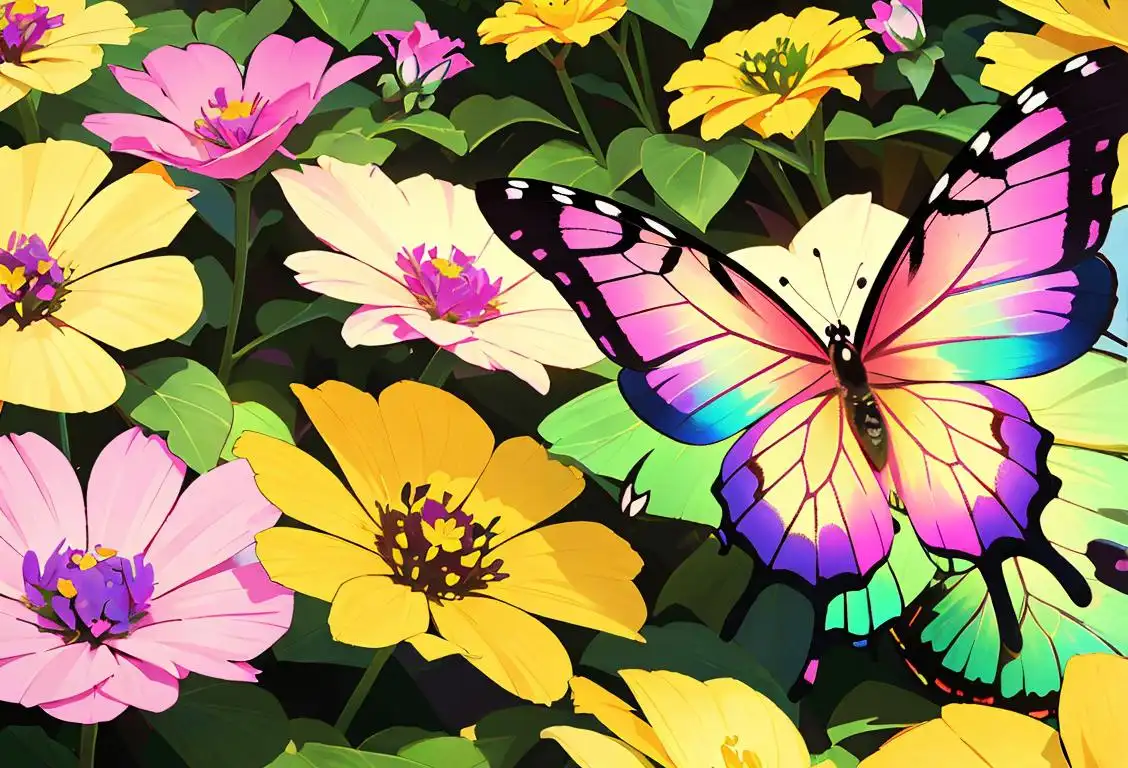National Butterfly Day

Welcome to National Butterfly Day, a day dedicated to celebrating the delicate and colorful creatures that grace our gardens and make our hearts flutter with joy!
When is Butterfly Day?
It's national butterfly day on the 14th March.
Fluttering into the History of National Butterfly Day
Did you know that butterflies have been mesmerizing humans since ancient times? These beautiful insects have enchanted us with their vibrant colors and graceful flight. It's no wonder we set aside a special day to appreciate them!
National Butterfly Day originated on March 14th, 2011. This delightful day was established to raise awareness about the importance of butterflies in our ecosystem and to promote their conservation.
But why butterflies, you ask? Well, these lovely creatures serve as pollinators, helping plants reproduce and maintain biodiversity. They also indicate the overall health of our environment. So, by celebrating National Butterfly Day, we're not just admiring their beauty, but also honoring their vital role in nature.
How to Celebrate National Butterfly Day
If you're looking to embrace the spirit of this special day, here are a few ideas:
- Create a butterfly-friendly garden by planting nectar-rich flowers like lavender, milkweed, and coneflowers. These will attract butterflies and provide them with sustenance.
- Have a butterfly-themed crafting session with your loved ones. Make beautiful paper butterflies to decorate your home or create butterfly-shaped cookies to enjoy together.
- Visit a local butterfly garden or nature reserve and spend the day surrounded by these whimsical creatures. Learn more about their different species and observe their behavior up close.
- Support organizations dedicated to butterfly conservation and education by donating or volunteering your time.
Did You Know?
Did you know that the wings of butterflies are actually transparent? The vibrant colors and intricate patterns we see are created by the reflection and scattering of light through tiny scales on their wings. It's like nature's own stained-glass window!
History behind the term 'Butterfly'
c. 10th century
Origins of the term 'butterfly'
The term 'butterfly' is believed to have originated in the Middle English period around the 10th century. It was derived from the Old English word 'buttorfleoge', which is a combination of 'butor', meaning butter, and 'fleoge', meaning fly. This name was given to the insect due to the belief that they would steal butter and milk. The name was later shortened to 'butterfly'.
17th century
Scientific classification of butterflies
In the 17th century, advancements in scientific classification led to the study of butterflies. The Swedish botanist and zoologist, Carl Linnaeus, revolutionized classification by introducing the binomial nomenclature system. He classified butterflies under the order 'Lepidoptera', meaning scale-winged insects. This system allowed for more accurate categorization and study of butterflies and their diverse species.
19th century
Butterfly collecting and study
During the 19th century, butterfly collecting and study became a popular scientific and recreational activity. Naturalists and collectors began to explore different parts of the world in search of rare and beautiful butterfly species. This era saw the development of specialized equipment, such as nets and cases, to aid in the capture, preservation, and display of butterflies. Butterfly collecting also contributed to greater knowledge of the insect's behavior, habitat, and life cycle.
20th century
Symbolism and cultural significance
In the 20th century, butterflies gained significant symbolism and cultural significance. The delicate beauty and transformative life cycle of butterflies became powerful metaphors in various cultures. They symbolize rebirth, metamorphosis, and the transient nature of life. Butterflies have been associated with spiritual and artistic expressions, representing freedom, fragility, and the soul. Their vibrant colors and graceful flight have made them beloved subjects of artwork, literature, and fashion.
21st century
Conservation and ecological importance
In the 21st century, there has been an increased focus on the conservation and ecological importance of butterflies. Butterflies, as pollinators, play a crucial role in maintaining biodiversity and are indicators of environmental health. Efforts are being made to protect their habitats, promote butterfly-friendly gardening practices, and raise awareness about the importance of conserving these enchanting insects. Organizations and events dedicated to butterfly conservation strive to educate people about their ecological value and inspire action for a sustainable future.
Did you know?
Butterfly wings are transparent, and their vibrant colors are actually created by the reflection and scattering of light through tiny scales on their wings.Tagged
awareness fun loved onesFirst identified
14th March 2016Most mentioned on
14th March 2021Total mentions
552Other days
Compliment Day
Cheese Pizza Day
Pumpkin Day
Medal Of Honor Day
Guac Day
Foundation Day
Suicide Prevention Day
Memorial Day
Cancer Survivors Day
Bacon Day









